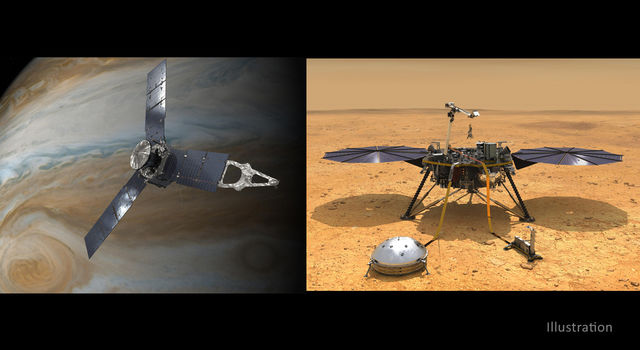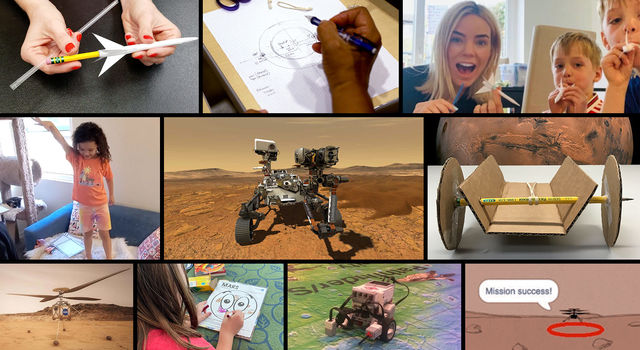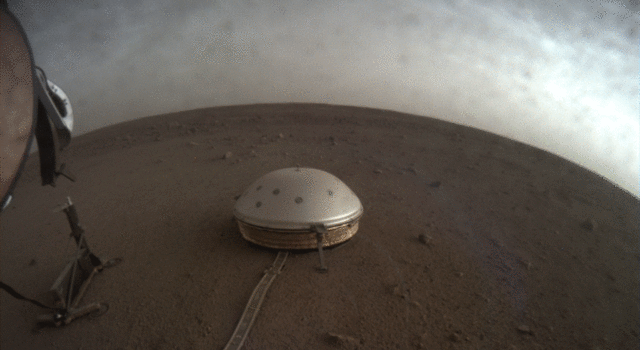Blogs | Dawn Journal | August 24, 2008
August 2008
Dear Dawnivores,
The Dawn spacecraft continues to make good progress on its adventure to unlock scientific secrets hidden deep in the main asteroid belt, between Mars and Jupiter. Its path to that distant realm of the solar system is now bringing it closer to the Sun, and thanks in part to all the thrusting it has accomplished with its remarkable ion propulsion system, it has recently achieved its lowest speed so far in the mission. To understand this enigmatic behavior, read on!
As most of you who have read about or visited the solar system know, the asteroid belt is much farther from the Sun than Earth is. Dawn passed outside the orbit of Mars in June, but it has not yet traveled far enough from the Sun to reach asteroid Vesta, its first destination. Dwarf planet Ceres, Dawn's second target, resides still farther in the depths of space. So readers with memories that extend as far back as the previous paragraph may wonder why Dawn apparently is backtracking, now approaching the Sun.
Despite the many innovations that make this project so fascinating, the Dawn team has not yet discovered how to travel backwards in time. (If it had, while writing this log, we would be able now to prevent the misspelling that occurred while writing the last log.) To see why Dawn seems to be reversing course, both heading toward the Sun and traveling more slowly now than at the beginning of its mission, we need to consider some of the principles that govern space travel.
Your correspondent offered some comments on these concepts in a log for a different interplanetary mission, Deep Space 1. If not for some unexpected legal issues with certain species in spiral galaxies capable of abstract thought, we would simply reprint that material here. Instead, we shall consider some of the same ideas but with different words.
The goal of this text is to provide only the gist of some of the fundamentals. In an act of selfless charity to help our hungry friends the Numerivores of Q2237+0305, this log will include more numbers than usual. It is not necessary to study them in detail; some readers may find them helpful and others may feel free to gloss over them. In any case, we can provide an absolute guarantee that by the end, with even a casual comprehension of this material, the interested reader would not find even the doctorate level examinations from the prestigious Galactic Institute of Space Travel (known to many as "the prestigious Galactic Institute of Space Travel") to be difficult.
The overwhelming majority of craft humans have sent into space have remained in the vicinity of Earth, accompanying that planet on its annual revolutions around the Sun. The satellites of Earth (including the moon) remain bound to it by its gravity. As fast as they seem to travel compared to residents of the planet, from a solar system perspective, their incessant circling of Earth means their paths through space are not very different from Earth's itself. Everything on the surface and in Earth orbit travels around the Sun at an average of around 30 kilometers/second (67,000 miles/hour), completing one full solar orbit every year. To undertake its interplanetary exploration and travel elsewhere in the solar system, Dawn needed to break free of Earth's grasp, and that was accomplished by the rocket that carried it to space last year. Dawn and its erstwhile home went their separate ways, and the Sun became the natural reference for the spacecraft's position and speed on its travels in deep space.
Despite the enormous push the Delta II rocket delivered (with affection!) to Dawn, the spacecraft still did not have nearly enough energy to escape from the powerful Sun. So, being a responsible resident of the solar system, Dawn remains faithfully in orbit around the Sun, just as do Earth and the rest of the planets, asteroids, comets, and other members of the Sun's entourage.
Whether it is for a spacecraft or moon orbiting a planet, a planet or Dawn orbiting the Sun, the Sun orbiting the Milky Way galaxy, or the Milky Way galaxy orbiting the Virgo supercluster of galaxies (home to a sizeable fraction of our readership), any orbit is the perfect balance between the inward tug of gravity and the inexorable tendency of objects to travel in a straight path. If you attach a weight to a string and swing it around in a circle, the force you use to pull on the string mimics the gravitational force the Sun exerts on the bodies that orbit it. The effort you expend in keeping the weight circling serves constantly to redirect its path; if you let go of the string, the weight's natural motion would carry it away in a straight line (ignoring the effect of Earth's gravity).
The force of gravity diminishes with distance, so the Sun's pull on a nearby body is greater than on a more distant one. Therefore, to remain in orbit, to balance the relentless tug of gravity, the closer object must travel faster, fighting the stronger pull. The same effect applies at Earth. Satellites that orbit very close (including, for example, the International Space Station, less than 400 kilometers from the surface) must streak around the planet at about 7.7 kilometers/second (more than 17,000 miles/hour) to keep from being pulled down. The moon, orbiting 1000 times farther above, needs only to travel at about 1.0 kilometers/second (less than 2300 miles/hour) to balance Earth's weaker grip at that distance.
Notice that this means that for an astronaut to travel from the surface of Earth to the International Space Station, it would be necessary to accelerate to quite a high speed to rendezvous with the orbital facility. But then once in orbit, to journey to the much more remote moon, the astronaut's speed eventually would have to decline dramatically. Perhaps speed tells an incomplete story in describing the travels of a spacecraft, just as it does with another example of countering gravity.
A person throwing a ball is not that different from a rocket launching a satellite (although the former is usually somewhat less expensive and often involves fewer toxic chemicals). Both represent struggles against Earth's gravitational pull. To throw a ball higher, you have to give it a harder push, imparting more energy to make it climb away from Earth, but as soon as it leaves your hand, it begins slowing. For a harder (faster) throw, it will take longer for Earth's gravity to stop the ball and bring it back, so it will travel higher. But from the moment it leaves your hand until it reaches the top of its arc, its speed constantly dwindles as it gradually yields to Earth's tug. The astronaut's trip from the space station to the moon would be accomplished by starting with a high speed "throw" from the low starting orbit, and then slowing down until reaching the moon.
The rocket that launched Dawn threw it hard enough to escape from Earth, sending it well beyond the International Space Station and the moon. Indeed, the spacecraft is now more than 1 million times farther away than the station. Dawn's maximum speed relative to Earth on launch day was so high that Earth could not pull it back. As mentioned in an earlier log, Dawn was propelled to 11.46 kilometers per second (25,600 miles per hour), well in excess of the space station's orbital speed given 3 paragraphs above. But it remains under the Sun's control.
If the spacecraft had never operated its ion propulsion system, it would have coasted away from the Sun (even while Earth continued circling the Sun on its own), slowing down the entire time, reaching the top of its interplanetary arc on July 2, 2008. Then, at almost 242 million kilometers (150 million miles) from the Sun, as it succumbed to the massive star's pull, it would have begun its inward fall.
Many solar system residents find measuring distances in millions of kilometers (or miles) to be inconvenient, so it is common to use the "astronomical unit" (AU). The average distance between Earth and the Sun, nearly 150 million kilometers (93 million miles) is defined to be 1 AU. So Dawn would have reached almost 1.62 AU from the Sun without thrusting.
After that, the probe would not have fallen all the way back to the Sun, ending in a useless blaze. Because it departed from Earth, which was already orbiting the Sun, and not from a stationary platform, it began with energy adequate to keep it at Earth's orbit. Upon allowing the Sun to pull it back, it would come only to about that same orbit, reaching a minimum distance of 1.00 AU from the Sun on April 1, 2009. So Dawn would have been in an elliptical solar orbit, ranging from 1.00 AU to 1.62 AU. It would have traveled faster and faster as it swooped to its smallest distance and then slowed down again as it sailed back out to the largest distance, much like a person on a swing, slowing near the top, speeding through the lowest point, and then repeating that pattern. The change in speed with distance is an essential characteristic of all orbits.
Now think again of the ball you throw. If it had a tiny propulsion system to help it along its way, that extra boost would propel it higher, supplementing the energy you imparted to it when it left your hand. Unlike a powerful rocket that accelerates as it ascends, if the additional thrust were low, it might not be able to completely counter the slowing from Earth's gravity, but it might help reach a higher altitude before beginning its fall.
As Dawn's famously efficient ion propulsion system has given it a delicate but steady push on its flight away from the Sun, the spacecraft has been able to resist the Sun's incessant pull longer. Instead of turning back in early July, Dawn flew outward until August 8. Even with all the thrusting, it was constantly slowing down, and when the Sun's gravity overwhelmed it, it began its inward flight. But by then the ion thrusting had changed the shape of its elliptical orbit so it would not fall back as far as Earth's orbital distance. If it undertook no more thrusting after August 8, it would come back only to 1.16 AU from the Sun, reaching that distance on June 14, 2009. As we will see in future logs, it will not have the opportunity to drop even that close to the Sun however, because ion propulsion continues modifying its orbit. In addition, on approximately February 18, 2009 (the exact date and time depend on the progress of future thrusting), the probe will pass by Mars, and the gravitational deflection will cause still more changes to its orbit around the Sun, which eventually will take it to the asteroid belt.
On September 27, 2007, some 2 minutes after it had separated from its rocket, Dawn reached its highest speed relative to the Sun for the entire mission. At that time, it was traveling at about 38.95 kilometers/second (87,130 miles/hour). Earth (and its residents, including this writer) were moving around the Sun at the more leisurely pace of 29.70 kilometers/second (66,440 miles/hour).
So what has been the effect of Dawn's thrusting since then? By August 8 it had expended about 55.4 kilograms (122 pounds) of xenon propellant, some for tests during the initial checkout phase of the mission and most with the specific intent of altering its orbit around the Sun. If this were solely for the purpose of accelerating (as it is usually described, in these logs and elsewhere) without the complex patterns involved in orbital dances, the effect would have been to increase Dawn's speed by 1.38 kilometers/second (3090 miles/hour). But because of the way forces and velocities work in space travel, in pushing Dawn away from the Sun, allowing it to travel "higher" before the Sun pulled it back, the ion propulsion system helped Dawn continue away from the Sun until, on August 8, it was more than 1.68 AU from the master of the solar system. By then, its speed had fallen to 20.77 kilometers/second (46,460 miles/hour). At the same moment Dawn was orbiting the Sun at that rate, distant Earth was racing in its orbit at 29.38 kilometers/second (65,710 miles/hour).
When Dawn began coming back in toward the Sun, it was in a different part of the solar system from where it would have been had it never applied its ion propulsion system to so patiently yet persistently change the orbit the Delta rocket left it in. In the absence of any ion thrusting, the spacecraft would have been 0.45 AU (68 million kilometers or 42 million miles) away from its actual location on August 8.
Dawn will rendezvous with Vesta in about 3 years. To match that asteroid's orbit around the Sun, our robotic explorer will have to continue tuning its orbital parameters so that it will be almost 2.3 AU from the Sun while traveling at about 20 kilometers/second (45,000 miles/hour), farther and slower than its current orbit or that of its quondam planetary domicile.
Achieving the required speed and distance alone is not enough to ensure Dawn can slip into orbit around Vesta, but we will consider other aspects of this problem in a future log. In the meantime, we can think of the general problem of flying elsewhere in space as similar to climbing a hill. For terrestrial hikers, the rewards of ascent come only after doing the work of pushing against Earth's gravity to reach a higher elevation. Similarly, Dawn is climbing a solar system hill with the Sun at the bottom. It started from Earth, at 1 AU in elevation; and its first rewards await it higher up that hill at 2.3 AU, where Vesta, traveling at only about two thirds of Earth's speed, keeps its records of the dawn of the solar system. Ceres is still higher up the hill, moving even more slowly to balance the still-weaker pull of the Sun.
If this were only a climb, it would be easy to stop at the correct spot on the solar system hill. This simple analogy fails us here though, because everything is in orbital motion. With a big enough rocket, or gravitational boosts, it would not be difficult to throw Dawn hard enough that it would fly out to Vesta or beyond, and some other spacecraft have coasted past that distance from the Sun. But to enter orbit, Dawn must precisely match Vesta's path around the Sun, joining it for a portion of the asteroid's regular 3.6-year circuit around the Sun, just as Earth's natural and human-made satellites stay with it throughout its 1-year orbit. That is part of the reason the spacecraft needs ion propulsion. The ion propulsion system allows Dawn not only to carry its scientific instruments up that hill but also to "stop" on the slope, neither falling back toward the Sun nor coasting by the asteroid. When a subsequent log addresses what more is required than speed and distance, we will see why this is more difficult than it may appear. (And as we surely will have a link from that log to this one, on behalf of all present readers, we send greetings from the past to you future readers.) We are confident that in meeting this great challenge, should Dawn remain healthy, it will be a shoo-in in the next solar system Olympics, aiming not for a bronze medal, nor for one of silver or gold but rather for the most highly coveted: the xenon medal.
We promised near the beginning that for those who completed this arduous log (perhaps a challenge even greater than Dawn's interplanetary journey), the examinations at the prestigious Galactic Institute of Space Travel would not prove difficult. The reason is simple: there is no such organization; we made it up. Nevertheless, following Dawn's long and ambitious journey does not require mastery of the concepts touched upon here. All that really is needed is the desire to learn more about the cosmos, to share in one of humankind's bold adventures to explore the unknown as we set our sights on extraordinarily distant goals and aspire to something well beyond the confines of our humble home in the universe.
Dawn is 352 million kilometers (219 million miles) from Earth, or 955 times as far as the moon and 2.33 times as far as the Sun. Radio signals, traveling at the universal limit of the speed of light, take 39 minutes to make the round trip.
Dr. Marc D. Rayman
9:30 pm PDT August 24, 2008
TAGS:DAWN, VESTA, CERES, DWARF PLANET, MISSION, SPACECRAFT







